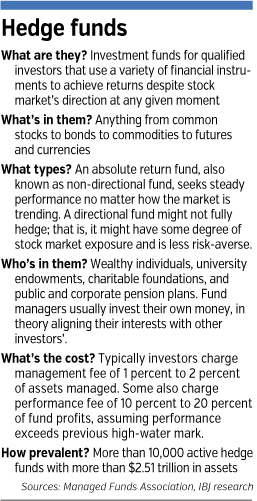Subscriber Benefit
As a subscriber you can listen to articles at work, in the car, or while you work out. Subscribe NowBefore the market crash, they were the wunderkinds of the investment world, often heralded for achieving double-digit returns for their wealthy clients.
Hedge fund managers profess to provide investors a hedge against a poor-performing market—a way to dampen market volatility. They often use alternative investments such as commodities or selling stock index futures over varying periods of time that provide returns uncorrelated with the stock market.
Instead, many of the nation’s hotshot investment managers chased high returns, bringing double-digit losses at giants such as Cerberus Capital and Citadel Investments.
 “As to their ability to insulate people against crashes, I would guess the investment community doesn’t see them as much as masters of the universe” anymore, said Charles Trzcinka, a finance professor at the Indiana University Kelley School of Business.
“As to their ability to insulate people against crashes, I would guess the investment community doesn’t see them as much as masters of the universe” anymore, said Charles Trzcinka, a finance professor at the Indiana University Kelley School of Business.
Five years after the crash, the luster of hedge funds isn’t what it used to be—witness a near-20-percent year-to-date rise in the Standard & Poor’s 500 index compared with the HFRI Fund of Funds Composite Index, up about 8 percent.
“To this day, hedge funds have struggled and haven’t been able to keep up with the market,” said J.R. Sauder, a partner in Indianapolis-based hedge fund Two Fish Management.
But he and firm partner Mike Morris are quick to qualify that the returns are raw. They don’t reflect the value over time of hedge funds to outperform during market downturns.
Since inception, in 2009, Two Fish’s annualized returns have been nearly 6 percent higher than the S&P 500 index: 27.1 percent vs. the S&P’s 21.3-percent rise.
“Since our strategy is significantly less volatile and uncorrelated to the market, our risk-adjusted returns are very high,” Sauder added.
Yet hedge funds remain a mystery to many and, unfortunately, one local fund wasn’t known for good things. Former Fishers hedge fund manager Keenan Hauke invested millions of dollars in Michigan real estate that became nearly worthless.
The bigger problem was that he covered up the losses by creating fake account statements and used money from new investors to pay off earlier ones. Dozens of investors lost more than $7 million. In 2012, Hauke was sentenced to 10 years in federal prison.
Other than Hauke, the few hedge funds based locally are mostly obscure. One reason is that their clients are often wealthy individuals, financial firms or retirement funds. The Indiana Public Retirement System has $1.9 billion in hedge funds, about 8.5 percent of its assets.
In April, the $27.1 billion fund announced $365 million in investments with hedge firms, eyeing expected long-term returns of 4.9 percent.
An individual investor’s net worth must exceed $1 million at the time of purchase, excluding the value of his residence. The threshold can be lower when factoring in a working spouse’s income.
Hedge fund investors also have to be prepared to leave their money in the fund for a while, as they’re generally more illiquid—sometimes locking in a client for at least two years.
An investor also will a pay a management fee, generally 1 percent to 2 percent of assets managed. Some also charge an incentive fee, based on 10 percent to 20 percent of fund profits—assuming the fund is profitable and exceeds a previous high known as a high-water mark.
Another aspect of hedge funds is that managers usually have a big portion of their own money on the line. In theory, “that concentrates your mind,” Trzcinka said. “They are not caretakers. They are actually active investors.”
“I have significant skin in the game in that a majority of my family’s investable assets are in the fund and invested along with partners,” said Ryan Fuhrmann, who runs Carmel hedge firm Fuhrmann Capital.
Lots of flavors
Aside from some of the basic characteristics, one hedge fund can be radically different from another in its investment focus. Two Fish, for instance, makes much of its money by selling out-of-the-money put options.
Sauder is a former business valuation analyst at local accounting firm Katz Sapper & Miller, and Morris is former director of investment research at KSM Capital.
Since founding the firm six years ago, the duo has $250 million of funds under management. They’ve also been making a name for themselves outside of Indiana.
Earlier this year, Morris found himself on Canada’s CBC television network and in Toronto’s Globe and Mail newspaper after his research suggesting a way to turn around one of the worst-performing mining groups, Toronto-based Barrick Gold.
Two Fish also wound up in Barron’s for its contention that Barrick should sell or spin off its business units outside of the Americas.
“We spend a lot of time on boring businesses,” Sauder said of some of the stocks.
Meanwhile, at Fuhrmann Capital, Furhrmann is using his analytical acumen to invest in primarily large-cap stocks on behalf of individuals. He also has interest in two smaller private institutions, including the National Bank of Indianapolis.
“I don’t do anything with futures or commodities and don’t really plan to,” said Fuhrmann, also an adjunct professor at Butler University. “I am better at predicting how a well-run business performs over a three- to five-year cycle, or entire business cycle.”
His holdings generally consist of stocks with a solid track record and good management, including Caterpillar, Deere and MetLife. Since founding the firm in 2007, Fuhrmann’s holdings have returned 2.45 percent above the S&P 500 index, net of investment management fees.
“I am for a stock that doubles over five years, which works out roughly to a 20-percent annual return,” Fuhrmann said.
“This obviously didn’t happen during the height of the financial crisis, but we have been pleased with our results since.”•
Please enable JavaScript to view this content.
